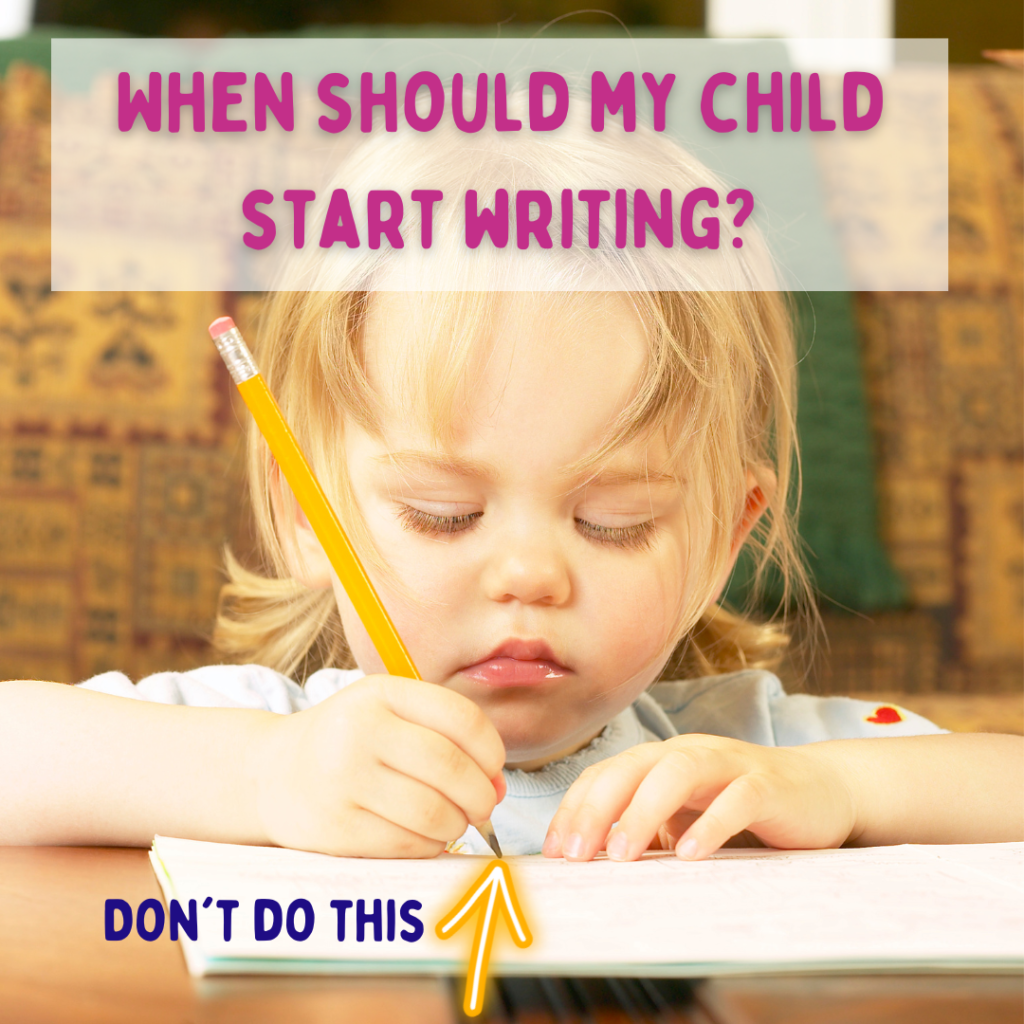When should my child start writing?
Should my child be writing more?

Writing can be a very stressful part of learning for both parents and children. Often, we feel that our child’s reading is ‘good enough’ or ‘getting there’, but their writing is barely just starting.
In my years in the classroom, I’ve often heard parents worry that their child can read CVC words, but can only write their name (and even that looks messy!). I’ve written this blog as an easy resource to help parents understand how writing progresses, how to help encourage writing (when your little one is ready) and hopefully calm some worries that your child isn’t writing!
Hand development and writing
The main reason why younger children find writing harder is due to physical development. In a child of 4, the bones of the hand are still growing and have not yet fused fully. Below are two x-rays. The one on the left is the hand of a 7 year old and the one on the right is a 4 year old. You can see how dramatic the difference is!

As the bones and muscles are not fully developed, your child has less control over their grip than they will have in a few years. Trying to control their pencil at this stage may lead to them hunching their shoulder or balancing their elbow on the table, both of which can lead to more problems and discomfort. Encouraging your child to stand while they are writing (or wiggle, or jump or move in general) is actually helping them develop their core stability, and their motor skills!
Mark making and attributing meaning to shapes
Some children might be very keen to write at 4, but not every child is ready, just as not every child is ready to read, or skip, or play football! All children, however, want to create. Part of creating is ‘mark making’, which is an area that all children enjoy.
Mark making is exactly what it sounds like, making marks in a variety of ways. The next step is attributing meaning to the marks they make, and finally, writing. If your child is not ready to write (or doesn’t want to), mark making is an excellent step that encourages them to express themselves and builds fine and gross motor control at the same time!!
Mark making also does not have to be done with a pencil. In fact, until they have developed those muscles and skills in their fingers, regular pencils can be detrimental. Children just don’t have the control to use them! Instead, try chunky pencils, round paintbrushes, extra large chalks, stamps and finger painting. Making marks with these will help build wrist stability and finger isolation, making it easier for them to write in the future.
Building motor control – developing the skills for writing
In order to write, your little one needs to have a certain amount of development throughout their whole body. Building core strength helps children stay upright even when sitting down. Ever seen a child slumping at the dinner table? That’s because of their core strength! If they don’t have it, it can be exhausting trying to sit up straight.
Core strength can be developed by
- Using climbing frames and other playground apparatus – balancing as children move around climbing frames helps develop core strength and stability, as does climbing up, down and around.
- Sitting upright – when eating, encourage your child to sit up at a table. This helps them build their core muscles for short periods of time while they’re focusing on something else. If you eat with them, it can also help them with their communication and vocabulary skills!
- Spending time outside – playing outside in a park or forest, offers so many opportunities for your little one to develop core strength. Climbing, jumping, even rolling on the floor, all help mobility and build core muscles!
As well as core strength, your little one needs to develop ‘gross motor skills’, which essentially means the muscles in their arms and shoulders. Imagine you’re holding a pen in the air. Easy! But then I say you have to hold it like that for an hour. Suddenly, holding a pen becomes much more difficult. It’s the same for our kids. If we ask them to write, we’re asking them to ‘hold the pen’, using the muscles in their arms and shoulders to keep control of it. Again, if they’ve built those muscles, easy! But if not it can become an exercise in frustration.
Gross motor control can be developed by
- Climbing frames – climbing up and down helps with balance, core strength (to pull themselves up) and the muscles in their arms.
- Drawing large pictures – big movements like large circles, lines and shapes help to develop the range of movement while also mark making.
- Using different surfaces – instead of just writing on paper at a table, change the angle. Encourage your little one to write standing up against the wall, lying on the floor, or even upside down, under a table!
The final thing your little one needs is ‘fine motor control’ or the muscles in your fingers. This comes last because they are the smallest muscles and need all of the larger ones to work properly. These muscles control the tiny movements the pencil makes on the paper, forming letters. Again, they need to build strength in order to do this. Anyone who has ever had RSI knows how uncomfortable it can be to push your fingers past their comfort zone!
Things that can help your little one develop fine motor control:
- Play dough – pulling, squishing and shaping play dough helps build muscles in the fingers and arms, which will help with writing later on!
- Peg games – picking things up with tweezers or pegs helps build strength in the hand, making it easier to hold things, including a regular pencil.
- Finger games in nursery rhymes – nursery rhymes that include finger movements (like incy wincy spider or Tom Thumb) help with finger isolation, helping your child learn to control each finger. This helps with pencil grip and control. If you’d like to find out what else your child can learn from nursery rhymes, check out this blog – Do Nursery Rhymes help our children?
- Finger painting – again, this helps with isolation of movement, improving control (and it’s a lot of fun!)
A short introduction to pencil grip
I’m not going to write a whole section on pencil grip, but I do want to briefly go over the different stages and how the muscles are needed.
- Fist grip – relies on core and gross motor skills
- Pincer grip – begins to use fine motor skills as well, with some control of movement (using finger isolation)
- Standard pencil grip – requires all the muscles skills! This is the hardest one for children to learn, though it’s the easiest one to use to control a pencil!
Whichever one your child is on, hopefully this will help you to know which stage they need to be working on next!
If you’d like to find out more, check out this blog – Pencil Grip – mylittlelearner
Reading before writing
You might have heard it said, a child needs to read before they can write. This is essentially true, though I’ve definitely met children who find writing easier! What it really means, is children need to be able to hear sounds in words before they can write them.
Developing listening skills helps our children to identify sounds in words, making writing much easier, what ever stage their muscles are at! If you’d like to learn more about listening skills, you can check out my blog here – 10 Listening Games that will help your child.
Valuing writing and self-expression
I could write a whole blog post on this – and may well, soon – but valuing writing in your daily life is a brilliant way to encourage your child to write.
Praising your little one when they mark make and encouraging them to tell you about what they’ve drawn or written shows that you value their effort and will solidify in their minds that writing is a good thing!
Equally, encouraging your little one to draw their feelings or ideas helps them begin to recognise the link between mark making and communication. Once they’ve made this link, it is likely they will be more enthusiastic about communicating in this way and eventually, writing down their thoughts.
If you’ve found this blog post useful or interesting, please join my Facebook group, where I regularly post tips and support for parents of Reception children. It’s a wonderful, supportive community for parents where you can share your wins and get answers to your questions. We’d love to have you!